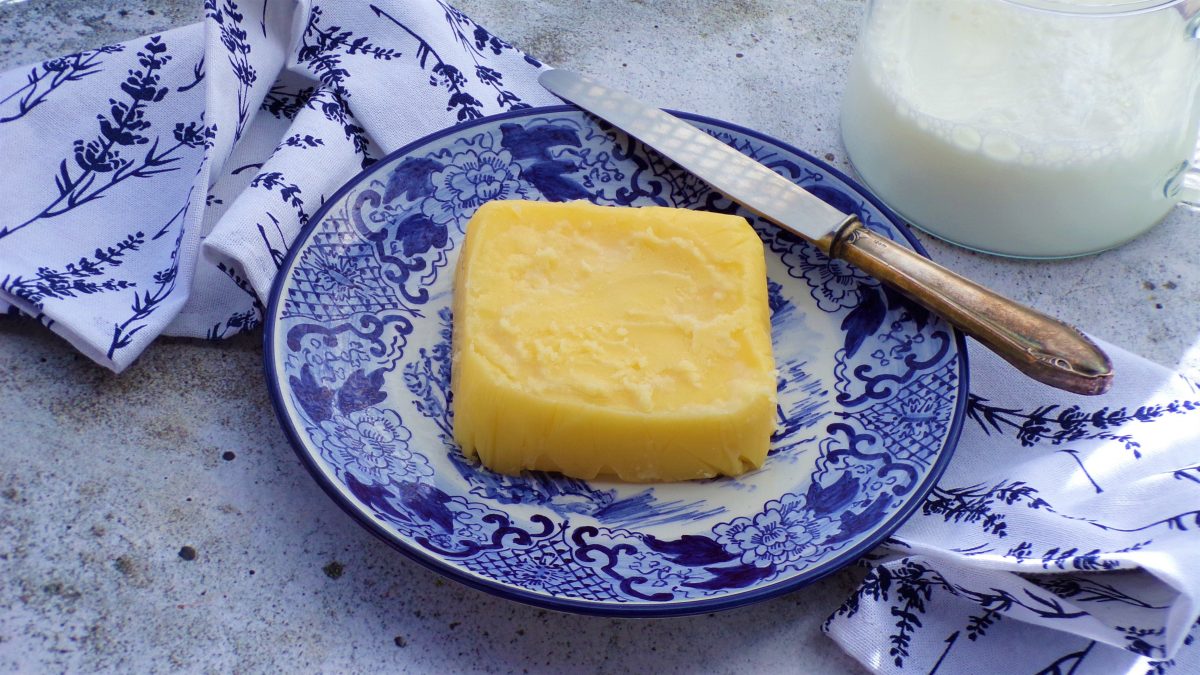
Clarified Butter, known in Asia as ghee, is an animal fat obtained from the so-called clarification process of butter, a heat treatment that makes it clear and removes water and casein, the milk protein. In addition to making it suitable for those intolerant to lactose, this process makes it ideal for frying, as it increases its smoke point, taking it from 266°F/130°C to 356°F/180°C. A high smoke point ensures perfect frying without the risk of burning the food, which is why clarified butter is used for cooking dishes such as Milanese cutlet.
It is, if you look closely, a concentrate of fats: by eliminating the percentage – equal to 18% – of water and casein contained in traditional butter, clarified butter is in fact composed of 100% fats. Of these, 60 percent are saturated and short-chain, so they are used by our body in a similar way to carbohydrates, playing a beneficial role in health. This characteristic makes it healthier and more digestible than classic butter, so much so that in Indian Ayurvedic medicine it is considered a "miraculous" product for its digestive and antioxidant properties. It is no coincidence that it is also one of the main ingredients of chapati, the typical Indian bread served with traditional dishes.
Making clarified butter at home is much simpler than you might think: the butter cut into pieces is cooked in a bain-marie; once melted, the watery part that rises to the surface is eliminated, while the fatty part is filtered and then left to solidify in the refrigerator.
What is Clarified Butter?
Clarified butter has a long history dating back to ancient times. It originated in the Indian subcontinent, where it is known as ghee. The process of clarifying butter involves melting it and removing the milk solids and water, leaving behind pure butterfat. This method extends the shelf life of butter and makes it ideal for high-heat cooking. Ghee became an essential part of Indian cuisine, valued not only for its cooking properties but also for its medicinal uses.
Clarified butter later spread to other parts of the world, including the Middle East and Europe. In Europe, it became popular in Mediterranean and French kitchens, where it was used for making sauces and enhancing the flavor of dishes. The concept of clarified butter reached the United States in the 18th and 19th centuries, primarily through European immigrants. Over time, it became known for its health benefits, particularly in low-carb and keto diets, due to its higher concentration of healthy fats compared to regular butter. Today, clarified butter (or ghee) is a common ingredient in various cuisines around the world, especially in cooking that requires high temperatures.
How is Clarified Butter Different From Butter?
Clarified butter is different from regular butter because the milk solids and water are removed, leaving only pure butterfat. This makes clarified butter more stable at higher cooking temperatures and gives it a longer shelf life compared to regular butter, which contains water and milk solids.
Clarified Butter Vs. Ghee
The main difference between clarified butter and ghee is that ghee is cooked longer, which caramelizes the milk solids, giving it a nuttier flavor and richer color. Clarified butter simply removes the milk solids without further cooking. Ghee has a more intense flavor and is commonly used in Indian cuisine, while clarified butter is popular in various global cooking styles.
Pro Tips for The Best Homemade Clarified Butter
- Start with unsalted butter to have better control over the flavor and salt content. This ensures a pure, clean taste in your clarified butter.
- Melt the butter over low to medium heat. This allows the milk solids to separate slowly from the butterfat, preventing them from burning or becoming too dark.
- As the butter melts, you’ll notice foam forming on the surface. Skim this off with a spoon. Then, let the remaining butter cook for a few more minutes until the milk solids sink to the bottom.
- Avoid stirring the butter while it's melting. This helps the milk solids separate more easily and gives you a cleaner result.
- Once the milk solids have settled at the bottom, strain the clarified butter through a fine mesh strainer or cheesecloth into a clean container to remove any remaining solids.
- A heavy-bottomed pan ensures even heat distribution, preventing hot spots that can burn the butter solids.
What Does Clarified Butter Taste Like?
Clarified butter has a rich, nutty flavor with a clean, buttery taste. It’s more intense and less milky than regular butter, due to the removal of milk solids and water.
What is The Best Butter to Clarify?
The best butter to clarify is unsalted butter. It gives you better control over the flavor and allows you to avoid any added salt, resulting in a purer, more versatile clarified butter.
Can I Use Salted Butter to Make Clarified Butter?
Yes, you can use salted butter to make clarified butter, but it will result in a slightly saltier product. If you prefer a milder taste, it's better to use unsalted butter.
How Do I Know When Butter is Clarified?
You’ll know the butter is clarified when the milk solids have fully separated and settled at the bottom of the pan, and the liquid is clear, golden, and free of foam on the surface.
Why Use Clarified Butter?
Clarified butter is ideal for high-heat cooking because it has a higher smoke point than regular butter. It also has a longer shelf life, a purer, richer flavor, and is lactose-free, making it suitable for those with dairy sensitivities.
Clarified Butter Substitutes
Some good substitutes for clarified butter include:
- Ghee – Very similar to clarified butter, with a nuttier flavor.
- Butter – Regular butter can be used, but it has a lower smoke point and contains milk solids.
- Coconut Oil – A dairy-free alternative with a high smoke point.
- Olive Oil – Offers a lighter flavor and is good for high-heat cooking.
- Vegetable Oil – A neutral-flavored oil suitable for various cooking needs.
What Can I Use Clarified Butter For?
Clarified butter is perfect for high-heat cooking, such as sautéing, frying, and roasting. It's also great for making sauces like hollandaise, drizzling over vegetables, or enhancing the flavor of dishes like popcorn, curries, and baked goods.
Can I Make It Ahead of Time?
Yes, you can make clarified butter ahead of time. It can be stored at room temperature for up to a few weeks or in the refrigerator for longer shelf life. Just make sure to keep it in an airtight container to preserve its freshness.
Does It Freeze Well?
Yes, clarified butter freezes well. You can store it in an airtight container or freezer-safe bag for up to 6 months. When ready to use, simply thaw it in the refrigerator or at room temperature.
How to Store Any Leftovers
To store leftover clarified butter, let it cool to room temperature, then transfer it to an airtight container. It can be kept at room temperature for up to 2-3 weeks, or in the refrigerator for longer storage (up to 6 months).
Ingredients
How to Make Clarified Butter
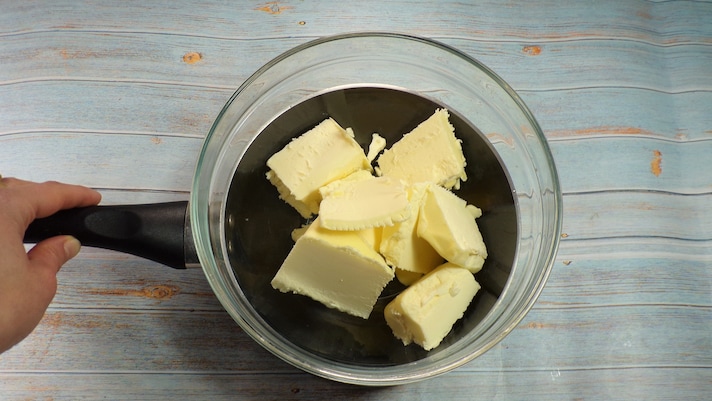
Start preparing the clarified butter by cutting the butter into cubes. Then melt it in a bain-marie, without ever stirring, placing the bowl over a saucepan full of water. At this stage, keep the flame at minimum: the butter must melt very slowly.
Start preparing the clarified butter by cutting the butter into cubes. Then melt it in a bain-marie, without ever stirring, placing the bowl over a saucepan full of water. At this stage, keep the flame at minimum: the butter must melt very slowly.
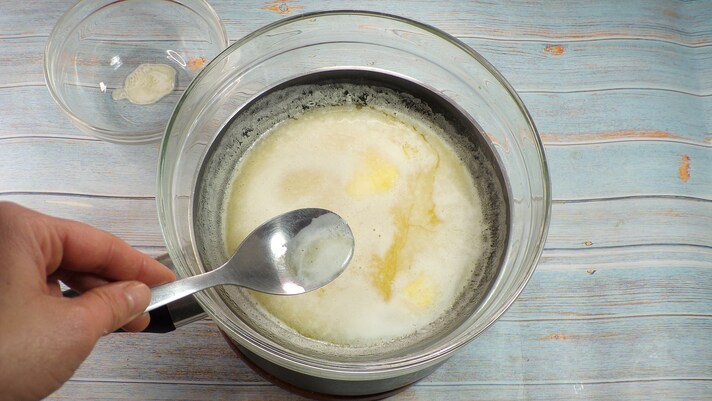
Once melted, you will notice that the most watery part of the butter will have come to the surface: remove it with the help of a spoon or a slotted spoon.
Once melted, you will notice that the most watery part of the butter will have come to the surface: remove it with the help of a spoon or a slotted spoon.
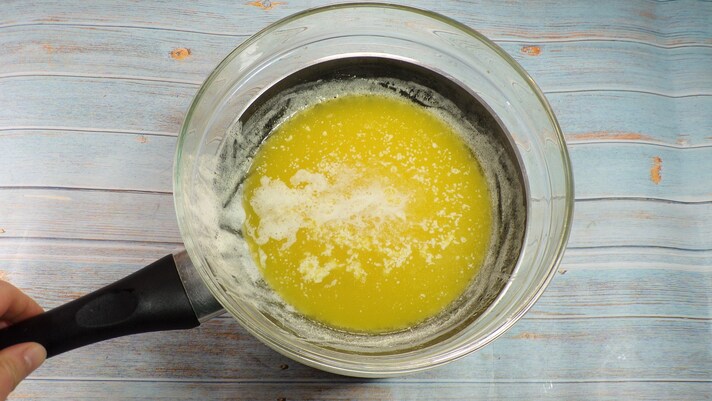
At the end of this operation, only the fatty part of the butter should remain, characterized by a fairly intense yellow color.
At the end of this operation, only the fatty part of the butter should remain, characterized by a fairly intense yellow color.
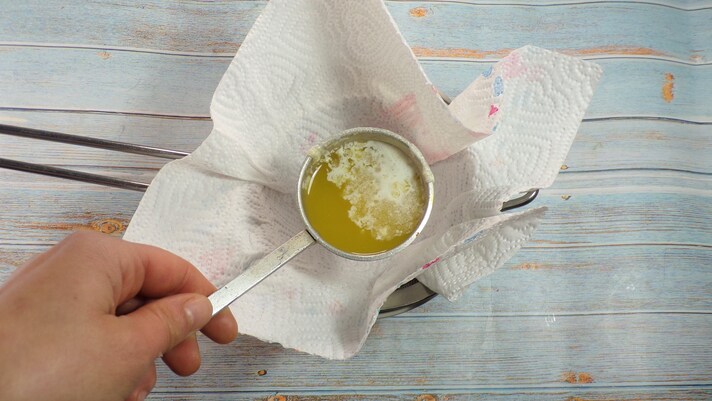
Now place a fine mesh sieve over a bowl, line it with kitchen paper or sterile gauze, and use it to filter the butter. Then let everything cool for a few minutes.
Now place a fine mesh sieve over a bowl, line it with kitchen paper or sterile gauze, and use it to filter the butter. Then let everything cool for a few minutes.
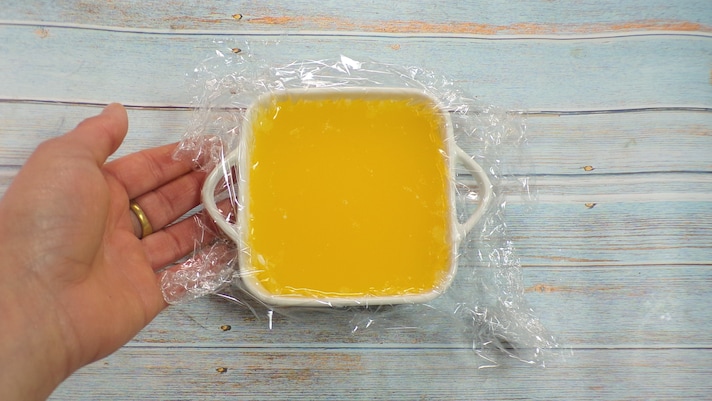
Meanwhile, line a mold or a small bowl with cling film, then pour in the clarified butter. Finally transfer it to the refrigerator and let it solidify well, it will take a few hours.
Meanwhile, line a mold or a small bowl with cling film, then pour in the clarified butter. Finally transfer it to the refrigerator and let it solidify well, it will take a few hours.
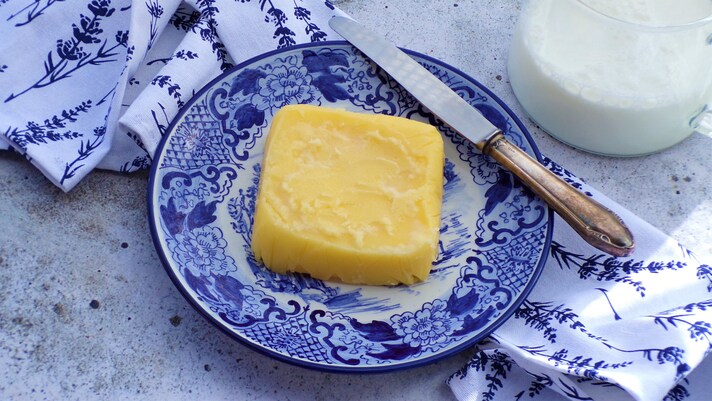
Once solid, turn the butter out onto a small plate, remove the cling film and use as desired.
Once solid, turn the butter out onto a small plate, remove the cling film and use as desired.
;Resize,width=767;)
